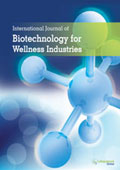ijbwi
|
|
Abstract: This study was aimed at selecting novel strains of Lactobacillus from crop of Algerian poultry. One hundred forty (140) lactobacilli strains were isolated and examined for their potentiality probiotic properties. From these isolated strains, nine appear to possess a probiotic value and highlighted a noticeable heterogeneity. The isolate L. plantarum G1 showed the best inhibitory activity against several indicator strains. Furthermore, the results showed that culture and neutralized supernatants exhibited varying degrees of inhibitory activity against strains of enterobacteria from poultry origin. The tested strains were acid resistant and were also bile tolerant. Antibiotic resistance, co-aggregation activity and hydrophobicity percentage were strain-dependent. Moreover, six strains were able to adhere to epithelial cells. Finally, six Lactobacillus strains, such as strain L. plantarum G1, L. plantarum PC2, L. viridesencs G3, L. helveticus PC6, L. delbrueckii ssp delbrueckii G7 and L. fermentum PC8, showed essential probiotic properties. The identity of the best strain L. plantarum G1 was confirmed by 16S rRNA gene sequence using PCR. Keywords: Lactobacillus, Poultry crop, Probiotic properties, Adhesion.Download Full Article |
|
|
Abstract: Processing is a critical aspect of herbal based products, and processing method is known to affect the content, activity and bioavailability of bioactive compounds. Extraction of oleoresin from Curcuma xanthorriza is effected by several processing parameters. Appropriate solvent selection such as polar solvent result in better extraction yield while lower polarity solvent end up with extracts having higher concentration of active compounds. In this study, different processing parameters were carried out including blanching treatment (boiled, steamed) at range of time (24 hours, 48 hours and 72 hours), solvent of extraction (methanol, ethanol and acetone). The curcuminoid content and antioxidant activity were determined in Curcuma xanthorriza oleoresin. The result obtained was proved that ethanol was the most effective solvent. Blanching treatment affects the yield of oleoresin and promotes the release of curcuminoids content. Keywords: Curcuma xanthorriza, optimisation, blanching, solvent, antioxidant activity.Download Full Article |
|
|
Abstract: Honey isolate Aspergillus niger EM77 was a good halophilic invertase producer in the presence of wheat bran as a complete medium (114.55 U/g), using solid state fermentation technique. Different parameters influence the enzyme productivity such as different pH values, temperature, incubation period, nitrogen and carbon sources were investigated. The optimum pH, temperature and incubation period for enzyme production were 5.5, 30oC and 72 hrs, respectively. Sucrose at 2 % was more suitable carbon source for invertase production (144.39 U/g) and (NH4)2SO4 at 0.15 % was the ideal nitrogen source. Among different metals ions MnSO4 enhanced the enzyme productivity than other tested ions to 194.71 U/g. The partially purified enzyme was successfully entrapped in polyvinyl alcohol sponge shielded with agar starch layer (PVAsp Gs) and achieved 71% immobilization yield. The optimum conditions for immobilization were: pH 5.2, an incubation time of 15 min and a protein concentration of 250 mg/ml. Immobilized enzyme was reused 12 times with 29% activity loss. The free enzyme lost its activity completely at 70˚C after 45 minute and the immobilized form retained 80% of its activity at the same condition.The free and immobilized form reported extreme halophilic property since the highest enzyme activity was obtained between 3.5- 5 M. Keywords: Honey isolate, invertase, Aspergillus awamori, immobilization, entrapment.Download Full Article |
|
|
Abstract: Two hundred and thirty one isolates, with the characteristic morphology of Genus Bacillus, were recovered from 100 soil samples collected from 7 different Egyptian governorates, and were screened for phospholipase C (PLC) production by egg-yolk plate method. Sixty isolates have shown very high PLC production and were further assessed using chromogenic assay method. The highest five producers, identified by 16S rRNA gene sequencing as Bacillus thuringiensis, were selected and their PLCs were purified to homogeneity using ammonium sulfate precipitation and Sephadex G-75 gel filtration chromatography. PLCs had molecular masses of 28.5 kDa as indicated by SDS-PAGE. The characteristics of the studied five PLCs were having maximal activities at 35-45°C and pH 7.2. The enzymes could retain more than half of their maximum activities at 30-60°C and pH 7-8. Equivalent activities were recorded at low water tension. PLC from B. thuringiensis KT159186 was relatively thermostable with a maximum activity at 40°C. The half-inactivation temperature was above 50°C, which compared favorably to that of other enzymes. Activity at the wide temperature range (20-80°C) was high (about 50% of maximum),. This PLC could tolerate pH as high as 12 with only 30% loss of activity. Specificity pattern of PLC from the same isolate showed equivalent activities toward phosphatidylcholine and phosphatidylinositol in addition to marked activity toward phosphatidylethanolamine, which makes it a typical non-specific PLC for industrial purposes. In conclusion, these characteristics of PLC from the test isolate make it attractive for various industrial applications. Keywords: Phospholipase C, Bacillus thuringiensis, Purification, Chracterization.Download Full Article |
|
|
Abstract: Biocements and biogrouts are developing extensively as new materials alternative to cement and toxic chemical grouts. The most popular type of biocement is a mixture of urease-producing bacteria, urea and calcium salt. Thus, development of biotechnology to produce biomass of urease-active bacteria for large-scale biocementation is an important biotechnological task. Two strains of urease-producing bacteria, Yaniella sp. VS8 and Bacillus sp. VS1 that synthesized inducible and constitutive urease, respectively, were used in the present study. It was shown that low cost biomass of urease-active bacteria can be produced from the hydrolyzed excessive activated sludge of municipal wastewater treatment plant. The biomass of Yaniella sp. VS8 grown in this medium diminished the hydraulic conductivity of sand from 4.8×10-4 m/s to 5∙10-8 m/s after severalbiotreatments with solution of 1.5 M urea and 0.75M СаCl2. Keywords: Bacillus sp., Yaniella sp., Activated sludge, Biocement, Biogrout.Download Full Article |





